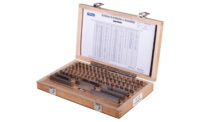With so many different calibration management software products on the market, choosing the best one for your business could prove challenging. First, one must assess basic company needs. Is only an inventory of gages needed, or do you also need the software to perform other functions, such as conducting gage R&R analysis? Do you need the software to integrate with other systems, or can it stand alone? Next comes the further evaluation and selection of features; for example, is the ability to create customized reports or generate work orders within the software important to you? Finally, and above all, is the matter of results. Will this software help your company better manage workload, minimize overtime costs, and maintain production schedules, while also meeting and upholding the standards required?
Fortunately, calibration management software continues to improve on the whole by becoming more multi-faceted, more adaptable to customers’ needs, and generally easier to use, with many software companies providing customized training and consulting options to make the learning curves less steep than they have been in the past.
For an inside look at the state of this software today, Quality spoke to Devin Ellis, Director of Client Solutions and Development at CyberMetrics—a software company that produces the calibration management software solution GAGEtrak—about management fundamentals, the importance of training, and what could be next for the industry at large.
Quality: For our readers who may not know, could you shed some light on the basics of calibration management software — how it works and why it matters?
Devin Ellis, CyberMetrics: Calibration management software essentially works as a database of the ‘what, when, and where’ of a company’s measurement and test equipment (M&TE). At the most basic level, our typical customer has to keep track of every device used to verify the quality of components they manufacture or those materials that they take in from suppliers. They have to verify or test each device on the floor to confirm that it is accurately reading each characteristic. Often, they are required to make adjustments or repairs to each device and document the findings, or they are required to pursue a corrective action (CA) if devices are found out of tolerance, and they will need to determine if the out-of-tolerance condition (OTC) affected their production quality, etc. This is a daunting task, and without calibration management software, it would be nearly impossible to effectively do this.
Beyond the basics, calibration management software brings powerful statistical analysis tools to bear, allowing a quality organization to take a statistical snapshot of the overall effectiveness of their calibration management system (or even their overall quality systems). If you can use gage studies to effectively manage how frequently you need to bring in M&TE for calibration and reduce that frequency, you can reduce your overall calibration costs and gain the added benefit of reducing your workload. Ultimately, these capabilities will allow you to focus on improving your quality system in proactive ways, as opposed to reacting to problems that arise from a poorly managed system.
We hear a lot about the importance of making software more user-friendly. Is your software designed to be intuitive, so that users can be easily trained? If so, how is this accomplished?
Software must be intuitive to be effective; if new users do not have a user-friendly product or training resources available from the start, any investment made in a product will ultimately fail, because users will not embrace it—this is bad for the developer and for the customer. We work hard to make our products as user-friendly and intuitive as possible. Ultimately, however, this software deals with complex subject matter and proper training is essential. Recognizing this crucial requirement, our involvement with our customer does not end with the purchase of our software —we offer as many affordable resources as possible to help them learn our software applications to a level that will ensure their success. Additionally, we take feedback from our customers, trainers, and support teams and apply their feature requests and user interface changes whenever possible in new versions. All of these efforts have supported the success of our products for nearly 30 years now, and it is our sincere desire to continue to learn from our customers’ ever-changing needs.
How do you ensure accuracy with your software?
Beyond our own testing and validation, we identify and utilize the best resources possible from the industries we serve. For instance, we have a Six Sigma Black Belt and an industry expert in Measurement Systems Analysis (MSA) who has worked with us for more than 15 years now to verify that our MSA elements are spot-on with common industry practices such as the AIAG MSA 4th Edition and the Guide to the Expression of Uncertainty Measurement (GUM). We are software developers with a strong grasp on common ISO and quality assurance practices, but working with industry experts goes a long way toward making sure that our products will help our customers meet their compliance needs now and in the future.
What new developments do you see coming down the pipeline for GAGEtrak, and also for calibration management software in general?
Without giving too much away, we are working on versions of our software that will answer the needs of a broader audience; from simple, lightweight versions to other versions that will meet enterprise-level or global needs. We are also looking at products that will allow for more effective gage management and control outside of the calibration lab.
As to the future of calibration software in general, we are seeing more and more of a global convergence of U.S., Asian, and European quality standards. This is forcing many software developers who serve the industry (and their respective cultures) to approach new development with more flexibility and a broader perspective. As industries continue to move discrete manufacturing outside of their borders, software must be capable of having a greater and more universal reach.



